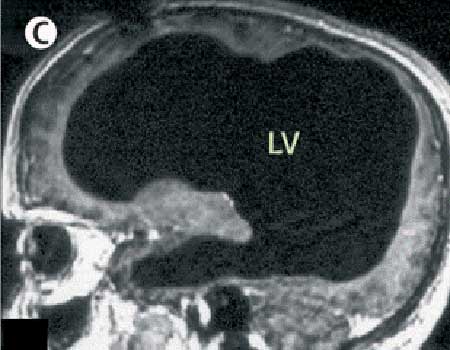Hydrocephalus: Difference between revisions
No edit summary |
No edit summary |
||
| Line 45: | Line 45: | ||
== Treatment == | == Treatment == | ||
[[Hydrocephalus surgery|Surgery]] | |||
== Case Studies == | == Case Studies == | ||
Revision as of 14:04, 22 July 2012
Template:DiseaseDisorder infobox
|
Hydrocephalus Microchapters |
|
Diagnosis |
|---|
|
Treatment |
|
Case Studies |
|
Hydrocephalus On the Web |
|
American Roentgen Ray Society Images of Hydrocephalus |
Editor-In-Chief: C. Michael Gibson, M.S., M.D. [1]; Associate Editor-In-Chief: Cafer Zorkun M.D., PhD.,Kalsang Dolma, MBBS
For patient information click here
Synonyms and keywords: Water on the brain
Overview
Historical Perspective
Classification
Pathophysiology
Causes
Common Causes, Causes by Organ System, Causes In Alphabetical Order
Epidemiology and Demographics
Risk Factors
Natural History, Complications and Prognosis
Diagnosis
History & Symptoms, Physical Examination, CT
Imaging Findings
Treatment
Case Studies
One interesting case involving a person with past hydrocephalus was a 44-year old French man, whose brain had been reduced to little more than a thin sheet of actual brain tissue, due to the buildup of fluid in his skull. The man, who had a shunt inserted into his head to drain away fluid (which was removed when he was 14), went to a hospital after he had been experiencing mild weakness in his left leg.

In July of 2007, Fox News quoted Dr. Lionel Feuillet of Hopital de la Timone in Marseille as saying: "The images were most unusual... the brain was virtually absent."[1] When doctors learned of the man's medical history, they did a computed tomography (CT) scan and another type of scan called magnetic resonance imaging (MRI), and were astonished to see "massive enlargement" of the lateral ventricles in the skull. Intelligence tests showed the man had an IQ of 75, below the average score of 100 but not considered mentally retarded or disabled, either.
Remarkably, the man was a married father of two children, and worked as a civil servant, leading a normal life, despite having little brain tissue. "What I find amazing to this day is how the brain can deal with something which you think should not be compatible with life," commented Dr. Max Muenke, a pediatric brain defect specialist at the National Human Genome Research Institute. "If something happens very slowly over quite some time, maybe over decades, the different parts of the brain take up functions that would normally be done by the part that is pushed to the side."[2]
See also
- Spina bifida
- Acquired hydrocephalus (causes of it)
- Arachnoid granulation
- Brain
- Cerebrospinal fluid
- Intracranial pressure
- Normal pressure hydrocephalus
- Cerebral shunt
- Subarachnoid space
- Ventricular system
- HEC syndrome
References
- ↑ "Man with Almost No Brain Has Led Normal Life", Fox News (2007-07-25). Also see "Tiny brain, normal life; French doctors are puzzling over the case of 44-year-old civil servant who has led a quite normal life -- but with an extraordinarily tiny brain", Physorg.com (2007-07-20); "Tiny Brain, Normal Life", ScienceDaily (2007-07-24).
- ↑ Man Lives Normal Life Despite Having Abnormal Brain
External links
- International Federation for Spina Bifida and Hydrocephalus (IF), the umbrella organisation for national spina bifida and hydrocephalus organisations
- Hydrocephalus Association at hydroassoc.org, US
- Information on fetal hydrocephalus at fetalhydrocephalus.com
- Is the brain really necessary? at flatrock.org.nz
- Living with congenital hydrocephalus at Associated Content
Template:Diseases of the nervous system Template:Congenital malformations and deformations of nervous system
ca:Hidrocefàlia da:Hydrocephalus de:Hydrocephalus id:Hydrocephalus it:Idrocefalo nl:Hydrocefalus no:Hydrocephalus sr:Хидроцефалија fi:Vesipää sv:Vattenskalle